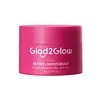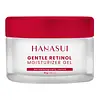What's inside
What's inside
 Key Ingredients
Key Ingredients

 Benefits
Benefits

 Concerns
Concerns

 Ingredients Side-by-side
Ingredients Side-by-side

Water
Skin ConditioningDimethicone
EmollientHydroxyethyl Urea
HumectantGlycerin
HumectantIsododecane
EmollientNiacinamide
SmoothingGlycereth-26
HumectantTrehalose
HumectantButylene Glycol
HumectantAllantoin
Skin ConditioningPhenoxyethanol
PreservativeAcrylates/C10-30 Alkyl Acrylate Crosspolymer
Emulsion StabilisingTromethamine
BufferingPolyglyceryl-6 Distearate
EmulsifyingHydrogenated Lecithin
EmulsifyingRetinol
Skin ConditioningDimethiconol
EmollientMethylparaben
PreservativePrunus Persica Fruit Extract
AbrasivePolyacrylate Crosspolymer-6
Emulsion StabilisingCarbomer
Emulsion StabilisingJojoba Esters
EmollientHexyldecanol
EmollientGlyceryl Glucoside
HumectantAmmonium Acryloyldimethyltaurate/Vp Copolymer
Ethylhexylglycerin
Skin ConditioningCetyl Alcohol
EmollientPolyglyceryl-3 Beeswax
EmulsifyingCeramide NP
Skin ConditioningPropanediol
SolventPentylene Glycol
Skin ConditioningCholesterol
EmollientAvena Sativa Kernel Extract
AbrasiveAroma
Chlorella Vulgaris Extract
Skin ConditioningLactic Acid
BufferingCentella Asiatica Flower/Leaf/Stem Extract
Skin ConditioningMatrine
AntioxidantEctoin
Skin ConditioningHydroxypinacolone Retinoate
Skin ConditioningHydroxyethylpiperazine Ethane Sulfonic Acid
BufferingAdenosine
Skin ConditioningCI 19140
Cosmetic ColorantWater, Dimethicone, Hydroxyethyl Urea, Glycerin, Isododecane, Niacinamide, Glycereth-26, Trehalose, Butylene Glycol, Allantoin, Phenoxyethanol, Acrylates/C10-30 Alkyl Acrylate Crosspolymer, Tromethamine, Polyglyceryl-6 Distearate, Hydrogenated Lecithin, Retinol, Dimethiconol, Methylparaben, Prunus Persica Fruit Extract, Polyacrylate Crosspolymer-6, Carbomer, Jojoba Esters, Hexyldecanol, Glyceryl Glucoside, Ammonium Acryloyldimethyltaurate/Vp Copolymer, Ethylhexylglycerin, Cetyl Alcohol, Polyglyceryl-3 Beeswax, Ceramide NP, Propanediol, Pentylene Glycol, Cholesterol, Avena Sativa Kernel Extract, Aroma, Chlorella Vulgaris Extract, Lactic Acid, Centella Asiatica Flower/Leaf/Stem Extract, Matrine, Ectoin, Hydroxypinacolone Retinoate, Hydroxyethylpiperazine Ethane Sulfonic Acid, Adenosine, CI 19140
Water
Skin ConditioningNiacinamide
SmoothingTrehalose
HumectantButylene Glycol
HumectantHydroxyethyl Urea
HumectantPropanediol
SolventGlycerin
HumectantPhenoxyethanol
PreservativeSodium Acrylate/Sodium Acryloyldimethyl Taurate Copolymer
Emulsion StabilisingDimethicone
EmollientVaccinium Macrocarpon Fruit Extract
AstringentPanthenol
Skin ConditioningAcrylates/C10-30 Alkyl Acrylate Crosspolymer
Emulsion StabilisingTocopheryl Acetate
AntioxidantAllantoin
Skin ConditioningC15-19 Alkane
SolventIsohexadecane
EmollientHydrogenated Lecithin
EmulsifyingAminomethyl Propanol
BufferingDisodium EDTA
Phytosteryl/Octyldodecyl Lauroyl Glutamate
Skin ConditioningSqualane
EmollientTriethylene Glycol
MaskingPolysorbate 80
EmulsifyingCaprylic/Capric Triglyceride
MaskingHydrolyzed Jojoba Esters
Skin ConditioningRetinol
Skin ConditioningC10-16 Alkyl Glucoside
EmulsifyingButyrospermum Parkii Butter
Skin ConditioningPolysorbate 20
EmulsifyingSorbitan Oleate
Emulsifying1,2-Hexanediol
Skin ConditioningSucrose Stearate
EmollientHydroxypinacolone Retinoate
Skin ConditioningCeramide NP
Skin ConditioningTetrahydropiperine
Skin ConditioningBHA
AntioxidantBHT
AntioxidantSodium Benzoate
MaskingArachis Hypogaea Oil
Skin ConditioningAscorbic Acid
AntioxidantBiotin
AntiseborrhoeicFolic Acid
Skin ConditioningPyridoxine Hcl
Skin ConditioningRetinyl Palmitate
Skin ConditioningTocopherol
AntioxidantBisabolol
MaskingCeramide AP
Skin ConditioningCeramide As
Skin ConditioningCeramide Ng
Skin ConditioningDimethylmethoxy Chromanol
AntioxidantGlycosphingolipids
EmollientWater, Niacinamide, Trehalose, Butylene Glycol, Hydroxyethyl Urea, Propanediol, Glycerin, Phenoxyethanol, Sodium Acrylate/Sodium Acryloyldimethyl Taurate Copolymer, Dimethicone, Vaccinium Macrocarpon Fruit Extract, Panthenol, Acrylates/C10-30 Alkyl Acrylate Crosspolymer, Tocopheryl Acetate, Allantoin, C15-19 Alkane, Isohexadecane, Hydrogenated Lecithin, Aminomethyl Propanol, Disodium EDTA, Phytosteryl/Octyldodecyl Lauroyl Glutamate, Squalane, Triethylene Glycol, Polysorbate 80, Caprylic/Capric Triglyceride, Hydrolyzed Jojoba Esters, Retinol, C10-16 Alkyl Glucoside, Butyrospermum Parkii Butter, Polysorbate 20, Sorbitan Oleate, 1,2-Hexanediol, Sucrose Stearate, Hydroxypinacolone Retinoate, Ceramide NP, Tetrahydropiperine, BHA, BHT, Sodium Benzoate, Arachis Hypogaea Oil, Ascorbic Acid, Biotin, Folic Acid, Pyridoxine Hcl, Retinyl Palmitate, Tocopherol, Bisabolol, Ceramide AP, Ceramide As, Ceramide Ng, Dimethylmethoxy Chromanol, Glycosphingolipids
 Reviews
Reviews

Ingredients Explained
These ingredients are found in both products.
Ingredients higher up in an ingredient list are typically present in a larger amount.
Acrylates/C10-30 Alkyl Acrylate Crosspolymer is a synthetic polymer. It is used to thicken and improve the texture of products. Due to its properties, it can prevent water and oil ingredients from separating.
Allantoin is a soothing ingredient known for its protective and moisturizingg properties. Because of this, it is often added to products with strong active ingredients.
Studies show higher concentrations of this ingredient can promote wound healing.
Though it can be derived from the comfrey plant, allantoin is produced synthetically for cosmetic products to ensure purity.
Learn more about AllantoinButylene Glycol (or BG) is used within cosmetic products for a few different reasons:
Overall, Butylene Glycol is a safe and well-rounded ingredient that works well with other ingredients.
Though this ingredient works well with most skin types, some people with sensitive skin may experience a reaction such as allergic rashes, closed comedones, or itchiness.
Learn more about Butylene GlycolCeramide NP is a type of ceramide and formally known as ceramide 3.
Ceramides are intercellular lipids naturally found in our skin that bonds dead skin cells together to create a barrier. They are known for their ability to hold water and thus are a great ingredient for dry skin.
Ceramides are an important building block for our skin barrier. A stronger barrier helps the skin look more firm and hydrated. By bolstering the skin ceramides act as a barrier against irritating ingredients. This can help with inflammation as well.
If you would like to eat ceramides, sweet potatoes contain a small amount.
Read more about other common types of ceramides here:
Ceramide AP
Ceramide EOP
Dimethicone is a type of synthetic silicone created from natural materials such as quartz.
What it does:
Dimethicone comes in different viscosities:
Depending on the viscosity, dimethicone has different properties.
Ingredients lists don't always show which type is used, so we recommend reaching out to the brand if you have questions about the viscosity.
This ingredient is unlikely to cause irritation because it does not get absorbed into skin. However, people with silicone allergies should be careful about using this ingredient.
Note: Dimethicone may contribute to pilling. This is because it is not oil or water soluble, so pilling may occur when layered with products. When mixed with heavy oils in a formula, the outcome is also quite greasy.
Learn more about DimethiconeGlycerin is already naturally found in your skin. It helps moisturize and protect your skin.
A study from 2016 found glycerin to be more effective as a humectant than AHAs and hyaluronic acid.
As a humectant, it helps the skin stay hydrated by pulling moisture to your skin. The low molecular weight of glycerin allows it to pull moisture into the deeper layers of your skin.
Hydrated skin improves your skin barrier; Your skin barrier helps protect against irritants and bacteria.
Glycerin has also been found to have antimicrobial and antiviral properties. Due to these properties, glycerin is often used in wound and burn treatments.
In cosmetics, glycerin is usually derived from plants such as soybean or palm. However, it can also be sourced from animals, such as tallow or animal fat.
This ingredient is organic, colorless, odorless, and non-toxic.
Glycerin is the name for this ingredient in American English. British English uses Glycerol/Glycerine.
Learn more about GlycerinHydrogenated Lecithin is created from the hydrogenation of lecithin (a group of phospholipids). Hydrogenation is a chemical reaction between hydrogen and another element.
This ingredient is an emollient and emulsifier. As an emollient, it helps soften skin by trapping moisture within. As an emulsifier, it prevents oil and water ingredients from separating.
This ingredient is a retinoid. It usually goes by a more common name: "Granactive".
Hydroxypinacolone Retinoate (HPR) belongs to the class of retinoids that also includes retinol and tretinoin.
Retinoids have been proven to:
So what is the difference between all the retinoids?
Most retinoids need to go through a conversion line to become effective on skin. The ending product is retinoic acid. Retinoic acid is AKA tretinoin.
HPR is an ester of tretinoin. Emerging studies suggest HPR to have an added benefit that other retinoids don't have: Low irritation.
A study from 2021 found HPR to have the greatest stability when exposed to light and temperature out of all the commercial retinoids.
A note about naming:
The name "Granactive" is the trade name and the name most commonly used on packages.
Granactive is the name of the mixture - about 90% solvent and 10% HPR. A product with 5% granactive has 0.5% HPR.
Learn more about Hydroxypinacolone RetinoateNiacinamide is a multitasking form of vitamin B3 that strengthens the skin barrier, reduces pores and dark spots, regulates oil, and improves signs of aging.
And the best part? It's gentle and well-tolerated by most skin types, including sensitive and reactive skin.
You might have heard of "niacin flush", or the reddening of skin that causes itchiness. Niacinamide has not been found to cause this.
In very rare cases, some individuals may not be able to tolerate niacinamide at all or experience an allergic reaction to it.
If you are experiencing flaking, irritation, and dryness with this ingredient, be sure to double check all your products as this ingredient can be found in all categories of skincare.
When incorporating niacinamide into your routine, look out for concentration amounts. Typically, 5% niacinamide provides benefits such as fading dark spots. However, if you have sensitive skin, it is better to begin with a smaller concentration.
When you apply niacinamide to your skin, your body converts it into nicotinamide adenine dinucleotide (NAD). NAD is an essential coenzyme that is already found in your cells as "fuel" and powers countless biological processes.
In your skin, NAD helps repair cell damage, produce new healthy cells, support collagen production, strengthen the skin barrier, and fight environmental stressors (like UV and pollution).
Our natural NAD levels start to decline with age, leading to slower skin repair, visible aging, and a weaker skin barrier. By providing your skin niacinamide, you're recharging your skin's NAD levels. This leads to stronger, healthier, and younger looking skin.
Another name for vitamin B3 is nicotinamide. This vitamin is water-soluble and our bodies don't store it. We obtain Vitamin B3 from either food or skincare. Meat, fish, wheat, yeast, and leafy greens contain vitamin B3.
The type of niacinamide used in skincare is synthetically created.
Learn more about NiacinamidePhenoxyethanol is a preservative that has germicide, antimicrobial, and aromatic properties. Studies show that phenoxyethanol can prevent microbial growth. By itself, it has a scent that is similar to that of a rose.
It's often used in formulations along with Caprylyl Glycol to preserve the shelf life of products.
Propanediol is an all-star ingredient. It softens, hydrates, and smooths the skin.
It’s often used to:
Propanediol is not likely to cause sensitivity and considered safe to use. It is derived from corn or petroleum with a clear color and no scent.
Learn more about PropanediolRetinol is a gold-standard ingredient for anti-aging. It is a form of Vitamin A and belongs to the class of retinoids that also includes tretinoin.
Why is retinol famous?
It has the most scientific studies backing up its skin benefits out of all the non-prescription ingredients.
Retinol is proven to:
This is why retinol is effective at removing wrinkles, fading dark spots, treating acne, and reducing the appearance of pores.
Studies show retinol is less effective when exposed to UV. Be sure to look for appropriate packaging to keep your retinol potent (similar to Vitamin C).
Using retinol or any retinoids will increase sun-sensitivity in the first few months. Though studies show retinoids increase your skin's natural SPF with continuous use, it is best to always wear sunscreen and sun-protection.
We recommend speaking with a medical professional about using this ingredient during pregnancy.
Retinol may cause irritation in some people, so be sure to patch test. Experts recommend 'ramping up' retinol use: start using this ingredient once a week and work up to using it daily.
Read about Tretinoin
Learn more about RetinolTrehalose is a disaccharide made of two glucose molecules (glucose is sugar!). Trehalose is used to help moisturize skin. It also has antioxidant properties.
As a humectant, trehalose helps draw moisture from the air to your skin. This helps keep your skin hydrated.
Due to its antioxidant properties, trehalose may help with signs of aging. Antioxidants help fight free-radical molecules, unstable molecules that may damage your skin.
In medicine, trehalose and hyaluronic acid are used to help treat dry eyes.
Some animals, plants, and bacteria create trehalose as a source of energy to survive freeze or lack of water.
Learn more about TrehaloseWater. It's the most common cosmetic ingredient of all. You'll usually see it at the top of ingredient lists, meaning that it makes up the largest part of the product.
So why is it so popular? Water most often acts as a solvent - this means that it helps dissolve other ingredients into the formulation.
You'll also recognize water as that liquid we all need to stay alive. If you see this, drink a glass of water. Stay hydrated!
Learn more about Water